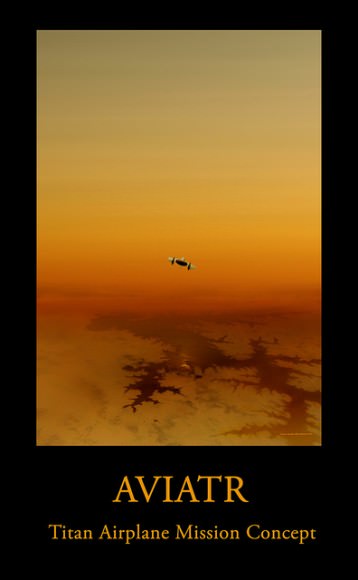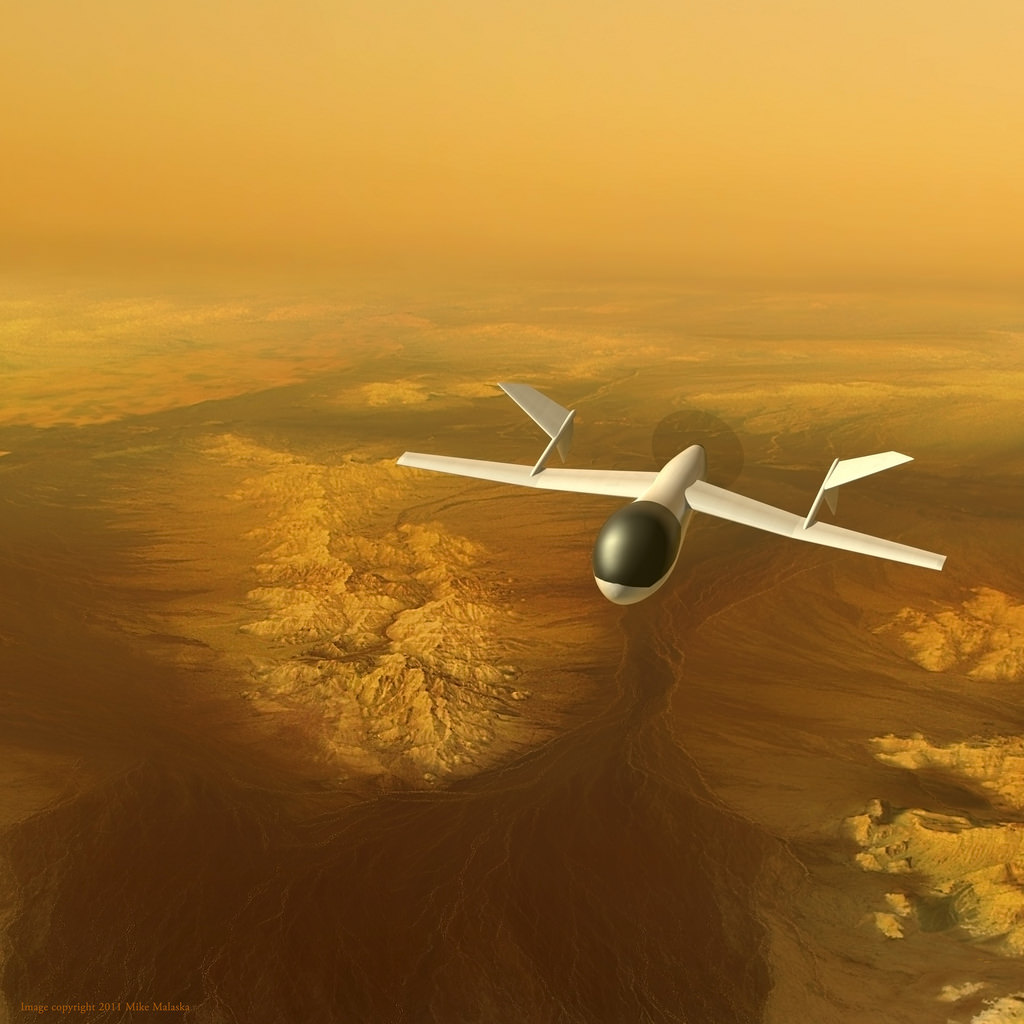[/caption]
It has been said that the atmosphere on Titan is so dense that a person could strap a pair of wings on their back and soar through its skies.
It’s a pretty fascinating thought. And Titan – Saturn’s largest moon – is a pretty fascinating place. After all, it’s the only other body in our solar system (besides Earth, of course) that has that type of atmosphere and evidence of liquid on its surface.
“As far as its scientific interest, Titan is the most interesting target in the Solar System,” Dr. Jason W. Barnes of the University of Idaho told Universe Today.
That’s why Barnes and a team of 30 scientists and engineers created an unmanned mission concept to explore Titan called AVIATR (Aerial Vehicle for In-situ and Airborne Titan Reconnaissance). The plan, which primarily consists of a 120 kg plane soaring through the natural satellite’s atmosphere, was published online late last month.
The goal of the plane concept – which according to Barnes can serve as a standalone mission or as part of a larger Titan-focused exploration program – is to study the moon’s geography (its mountains, dunes, lakes and seas), as well as its atmosphere (the wind, haze, clouds and rain. Did you know that Titan is the only other place is our solar system where it rains?)
AVIATR is composed of three vehicles: one for space travel, one for entry and descent into Titan, and a plane to fly through the atmosphere. AVIATR, estimated to cost $715 million, would not prevent other missions from occurring on Titan, Barnes said. Instead, it would supplement the science being done by other projects.
“The science that AVIATR could do complements the science that can be accomplished from both orbiting and landed platforms,” the article stated.
Unfortunately, it seems like the plane concept won’t be happening anytime soon.
That’s because Titan didn’t make the National Research Council’s “Decadal Survey” – a prioritization of future planetary missions. (Read more about the survey in this Universe Today post.)
“Titan was deferred to another decade,” Barnes said.
But, he hopes to continue to build support for AVIATR so that it can get onto the next decadal survey in 2020. “We certainly had a lot of interest from people. We are breaking the paradigm that a balloon was the right way to go to Titan,” Barnes said.
So, why send an unmanned plane to study Titan’s atmosphere?
“Titan is the best place to fly an airplane in the whole solar system. We can go when and where we want,” Barnes said, adding that when compared to Earth, there’s four times more air and seven times less gravity on Titan. “A balloon is stuck in the wind.”
According to the article:
“A balloon entrained in primarily zonal winds near the equator would have no mechanism by which to travel to the polar regions to observe lakes and shoreline processes. Even if it were possible to get there, it is not clear that it would be desirable to send a balloon to the poles where Titan’s most violent meteorological activity takes place. AVIATR is both able to fly to the poles and is sufficiently robust to survive there.”

There’s also this issue: A shortage of plutonium-238.
“The radioactive decay of plutonium-238 provides the heat that powers RTGs, which can power spacecraft where there is insufficient sunlight for solar panels to operate. NASA is presently investing in a new type of RTG, called the ASRG,” the article stated. “A traditional hot-air balloon will not work on Titan with an ASRG owing to its lower heat production. In contrast, the AVIATR mission is specifically enabled by the use of ASRGs. The power density (in Watts per kilogram) and longevity of the ASRG allow an electrically-powered aircraft to fly on Titan.”
A plane could also find potential landing spots for future exploration. And, “since we are flying, we fly west the whole time so we can stay on the day side of Titan,” Barnes said.
That daylight would also help AVIATR collect photographic data during its travels and, according to Barnes, when it’s time to downlink that information, the plane would conserve energy by gliding through the air.
“And in doing so, we can also sample of bunch of altitude ranges,” Barnes said. “We are sampling the whole time.”
The plan seems interesting enough, but it’ll be quite a while before any data from the prospective mission would be coming back to Earth. If the plan is accepted (the earliest being 2020), the project would still have to be built, then once completed it would take 7 1/2 years to reach Titan. Once there, the mission would take about a nominal Earth year to study.
“I now realize that it’s a career-long project,” Barnes said to Universe Today. “The plan at this point is to keep this in the forefront of people’s minds and take whatever new ideas that people suggest and try to improve its prospect for selection.
To view the complete proposal, published in Experimental Astronomy, go here.


I sure hope this happens, sooner or later. It would be amazing.
hmmm. what would it take to de-ice wings and camera lenses in hydrocarbon rain?
I must take issue with this comment from the Experimental Astronomy article, in its reasoning for why a balloon isn’t workable:
That may very well be true, but a balloon filled with a buoyant gas would not have that problem. In fact, such a balloon would have an advantage over AVIATR in that it would need much less power to function – only enough to power scientific instruments and communication. If it were equipped with a little wind turbine it might even be able to generate its own power for this purpose (although, with the balloon being blown about by the wind anyway, the turbine might not actually generate that much).
AVIATR certainly has its advantages too, but I think an intensive comparison is warranted here.
Never gonna happen
… never gonna buy
buy what? I’m not selling anything
Inc.
I’m not buying that either, Mr Inc.
What a technical marvel it would be. It would need some very sophisticated and reliable automation software though, as the Saturn system is too far away for mission planners to respond if the plane gets into trouble (a two-hour round-trip for radio transmissions).
That stands in stark contrast to the Mars rovers which are driven manually, movement by agonising movement, to ensure they don’t get stuck.
The RTG argument is silly, they could put in 4 ASRGs instead of 1 MMRTG to get enough thermal power. And such balloons has been envisioned not only as full hot-air balloons but as gas balloons with a hot gas height control bladder.
But it does point out that the airplane concept is more efficient for small loads. However if they can’t fit a mass spectrometer as their white paper claims, it is a suggestion that is questionable on its ability to get wide science society support. It is the organics of Titan that is one of its most alluring things, and AFAIK a mass spectrometer would be the simplest tool to start getting a characterization of them.
I think this should be the only other place where it rains onto the surface. All the dense atmosphere planets have wet precipitation of some form or other I think. In the case of Venus it is sulfuric acid rain “that evaporates around 25 km above the surface”. (Mars has snow, but it sublimates instead of melts.)
So you can take an airplane or balloon through some of that if you like. Btw, I wonder what warm sulfuric acid makes of a plane? =D
Anyway we explore it is ok with me, as long as we get out there and continue to explore our solar system! Let’s not compete either! Almost none of this can be confused with military uses. Hopefully when the Chinese finish flexing their orbital muscles, we can collaborate on some really awesome missions!
Okay, what I’d really like to see is a mission to a sizable asteroid to actually manufacture probes in low grav half way to their destinations! Titan, Triton, Enceladus, Europa…sigh!
I haven’t read their newly published 5 year white paper, but I have seen claims that the chinese take care to point out that they see space as a non-military volume. So they may very well lay a sound basis for collaborations.
The argument over balloons or aero-drones might be framed this way. It might be interesting to have another (post-Cassini) mission to Saturn which contains a number of components. I would love to see a gyroscope system similar to Gravity B placed around either Jupiter or Saturn, so one component might inset itself into a close orbit around Saturn. This will be a far more sensitive test of general relativity. Another component might have an aerogel that passes through the Enceladus geysers, which captures that material and returns to Earth. This part of the package might flyby the whole Saturnian system and return to Earth in a single orbital pass. Then another component can place an orbiter around Titan and drop a balloon into its atmosphere.
The Titan part of the mission would gain a better idea of the weather on Titan and to gather data required to keep a future drone in the Titan atmosphere. The reason is that we need a far more extensive idea of the weather or atmospheric dynamics. Just as with air traffic on Earth, meteorology is a necessary component of flying an aircraft. The aero-drone will have to avoid storms or squalls, and such a far future mission will require a Titan orbiting satellites which gather meteorological data and make predictions which permit navigation of this drone in a way to avoid weather that could destroy it. Since signals take over 3300 seconds (~ 1 hour) to traverse this distance and the drone is flying much faster than a rover, this may require some in situ computer guidance. That is a complicated system to develop.
LC
Here is a link to other AVIATR graphics on flickr: http://www.flickr.com/photos/31678681@N07/sets/72157623741262207/
It will be amazing; I hope this happens soon. I think it would be more interesting with an unmanned plane having plasma turbines using Titan’s atmosphere as propellant. http://www.youtube.com/watch?v=Uqnk19hn7Rc
“Did you know that Titan is the only other place is our solar system where it rains?”
I thought I read that Venus had sulfuric acid rain, and that gas giants have huge raindrops of liquid metal deep in the interiors, or something to that effect. Might be outdated info I was reading though.
Yes, partly mentioned, and Venus referenced, here.
Speaking of worlds with thick atmospheres, perhaps a similar contraption could be used to explore the upper skies of Venus?
@LoverBoy…?his is ?r?z?…?y fri?nd`s sist?r m???s 78/hr ?n th? int?rn?t. Sh? h?s b??n un?m?l???d f?r 11 m?nths but l?st m?nth h?r inc?m? w?s 7985$ ?ust w?r?ing ?n th? ?? f?r ? f?w h?urs. Read about it here …….http://alturl.com/53fye
Plane? Balloon? “Zeppeliner”? The later not necessarily need to be “closed” at the bottom.
Why take fuel there? I thought Titan was made of fuel!